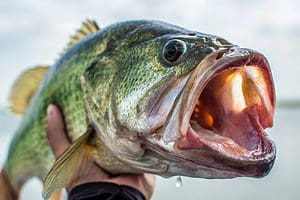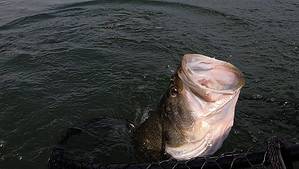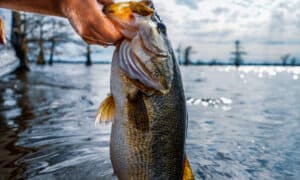Largemouth bass (Micropterus salmoides) are freshwater fish in the sunfish family. They’re originally from North America but have been introduced to other countries for sport fishing.
They’re a favorite among anglers because of their large size, aggressive behavior, and intense fight when caught. Read on to discover the largest largemouth bass ever caught in Connecticut, a record that has stood tall for over six decades.
How Big is the Largest Largemouth Bass Ever Caught In Connecticut?
According to official records of the Connecticut Department of Energy & Environmental Protection, Frank Domurat reeled in a whopping 12-pound largemouth bass in 1961. He caught it at Mashapaug Lake in Union, Connecticut. Despite 60 years passing, no one has ever surpassed this extraordinary feat.
Why is this Record So Hard to Beat?
Catching a largemouth bass of this size in Connecticut isn’t easy due to these factors:
- These fish have a short growing season here, unlike in southern states, where they can grow bigger and faster.
- Fishing is popular in the area. Most of them are caught and taken out before they reach their maximum potential.
- Strict bass fishing regulations like size and creel limits, catch-and-release areas, and closed seasons limit anglers’ chances of targeting trophy bass.
What is the Largest Largemouth Bass Ever Caught in the World?
George Perry: 22 Pounds, 4 Ounces
George Perry snagged a massive largemouth bass that weighed 22 pounds and 4 ounces, which smashed the world record over 80 years ago. This catch happened on June 2, 1932, at Montgomery Lake in Georgia. Perry used a Creek Chub Fintail Shiner bait to reel in the fish. After weighing it at a nearby post office, Perry entered it into Field & Stream magazine’s big fish contest.
Manabu Kurita: 22 Pounds, 4 Ounces
Only one angler, Manabu Kurita, has ever matched Perry’s record. Kurita is a Japanese fisherman who caught a 22-pound, 4-ounce bass on July 2, 2009, from Lake Biwa, Japan’s largest freshwater lake. His weapon of choice was live bluegill, and it took him approximately three minutes to reel in the monster.
After weighing the fish on a certified scale, Kurita submitted his catch to the IGFA (International Game Fish Association), which verified it as a new world record after a polygraph test. However, the association requires any new record to be at least two ounces heavier than the previous one. As a result, Kurita shares the title with Perry.
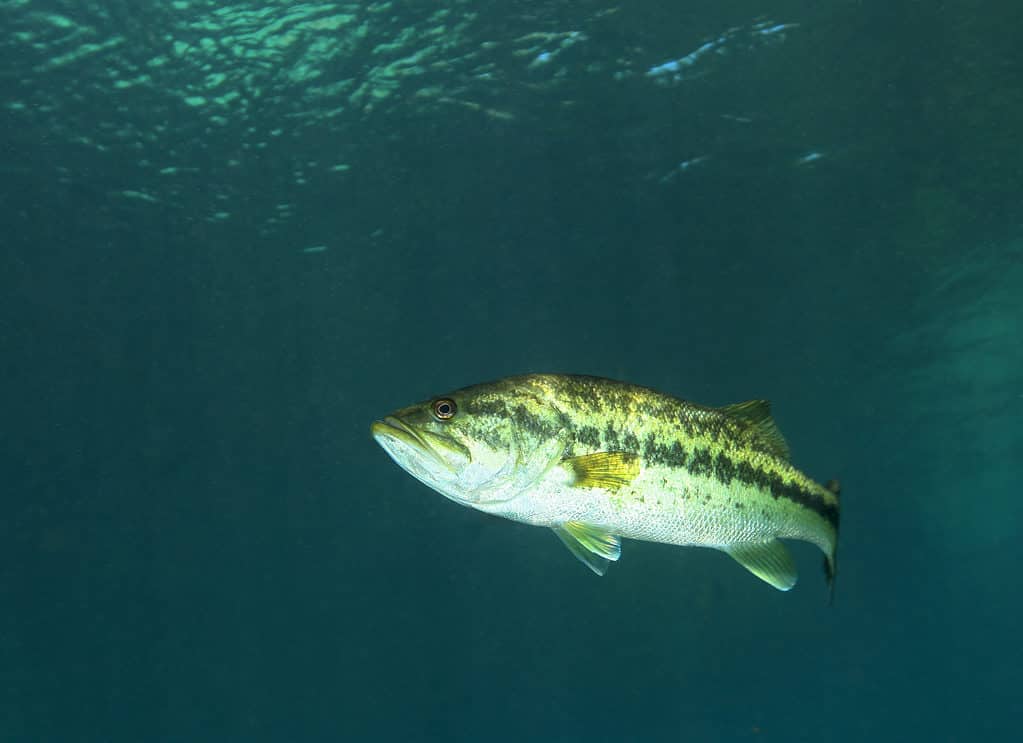
Manabu Kurita is the proud holder of a world record – 22 pounds, 4 ounces! His catch proves that anything is possible if you put your mind to it. Congratulations Manabu.
©iStock.com/mpwoodib
What are the Physical Characteristics of Largemouth Bass?
The largemouth bass is a sturdy fish with a wide mouth and a long head. Its body is not as flattened as the smallmouth bass. Adults have a lower jaw that extends beyond the eye, and their tongues are toothless.
The fish’s color ranges from dark brown on its back to green on its sides and white underneath. A dark stripe running down its side breaks up the green, giving it a slightly spotted appearance.
Juvenile largemouth basses have a more visible black edge on their caudal fin. Adult largemouth bass has two connected dorsal fins – the first with nine spines and the second with 12-13 soft rays.
They also have three anal spines and 10-12 soft rays on the anal fin. The lateral line has 58 to 73 scales, while the caudal peduncle has 24 to 28. Largemouth basses are typically 13-20 inches long and weigh 1-5 pounds. The oldest reported largemouth bass lived for 23 years.
What is the Habitat of the Largemouth Bass?
Largemouth bass fish are adaptable and can live in various habitats, though they prefer shallow, warm, and clear water with lots of plants and hiding spots. They can be found in many different types of bodies of water, like lakes, rivers, swamps, ponds, streams, and reservoirs. When it’s time for them to spawn, they prefer areas with a solid bottom made of sand, gravel, or mud.
Adult largemouth bass use underwater plants to ambush prey, while the young hide in submerged logs or weeds to avoid predators. They need the right amount of dissolved oxygen in the water to thrive. These fish do best in waters with warm or temperate climates, and the ones in the south grow up faster than those in the colder northern waters.
What Kind of Food Do Largemouth Bass Eat?
Largemouth bass are opportunistic predators that feed on various prey items depending on their size, season, and habitat. They typically consume smaller fish, crayfish, frogs, mice, and snakes. Largemouth bass have large mouths that allow them to swallow prey whole or in large pieces. They use their sight, smell, and lateral line system to locate and capture their food.
Interestingly, largemouth bass, like the northern pike, may sometimes turn cannibalistic. Additionally, they tend to avoid eating when the water is cold (below 41 degrees Fahrenheit) or hot (above 98.6 degrees Fahrenheit) or when they’re spawning.
How Do Largemouth Bass Capture Their Prey?
They have two different techniques – ram feeding and suction feeding. Ram feeding happens when a bass swims swiftly towards its prey, mouth wide open, and rams into it. This method is beneficial when the prey is quick and agile, such as a group of minnows or a fast-moving crawfish. The water’s force moves it to the bass’s throat, swallowing it whole.
Suction feeding, on the other hand, is a bit more subtle. It swiftly opens its mouth, creating a vacuum that sucks in water and anything nearby. Think of it like sucking up a milkshake through a straw! This strategy is incredibly effective when the target is loitering in or near the sediment at the water’s bottom.
However, most feeding events involve both of these methods simultaneously. When it sees a prey trying to escape, it’ll start using ram feeding to get closer swiftly. As it nears the target, it’ll transition to suction feeding, which creates negative pressure to suck in the prey. Using these techniques, the bass can be more adaptable in hunting tactics and increase its chances of nabbing a tasty meal.
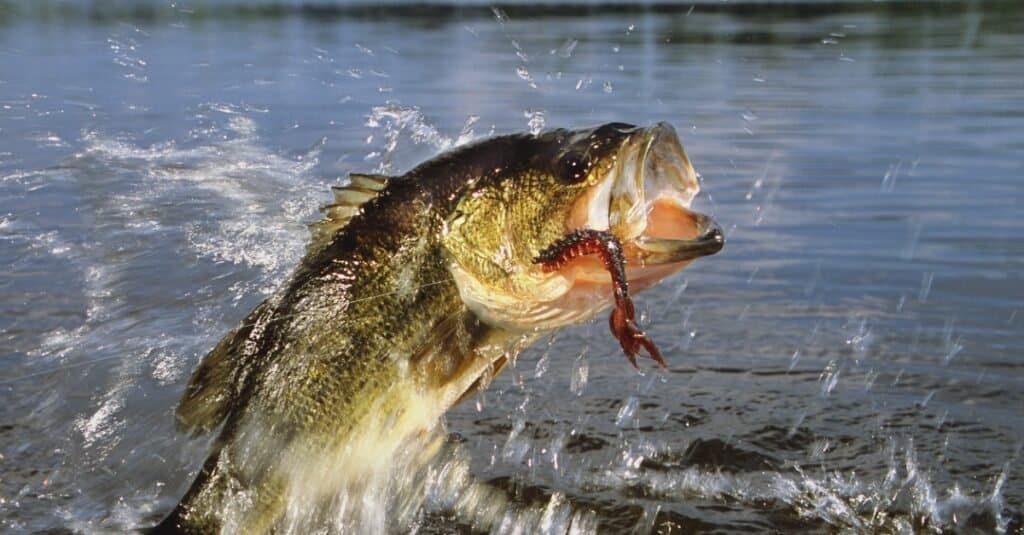
Largemouth bass are fierce. They’ve been known to quickly dart out of the shadows and snag unsuspecting prey with their powerful jaws.
©iStock.com/stammphoto
When Is the Best Time to Catch Largemouth Bass?
You can catch largemouth bass in Connecticut all year round, but summer is the best time because it’s when they’re most active. Your best chances of seeing them during this season are at dawn or dusk when the water is more relaxed and they’re most lively.
However, they retreat to deeper waters to stay cool when the midday sun beats down. During the spawning season in late May to early June, they move to shallower waters, making them more accessible targets.
Where to Fish for Largemouth Bass in Connecticut?
Connecticut has many lakes and ponds where you can find largemouth basses, but some stand out as exceptional fisheries. Here are some of the best places to fish for them in the state:
Candlewood Lake
Candlewood Lake is an artificial lake with a massive 5,420-acre area and an impressive 60-mile shoreline. The lake lies within Danbury, Brookfield, New Fairfield, Sherman, and New Milford. Each town offers a town beach for visitors to enjoy.
Candlewood Lake is famous for its trophy smallmouth bass but also produces trophy largemouth bass. Smallmouth bass tends to favor the northern parts of the lake, where the water is deeper and rockier. In contrast, largemouth bass are more prevalent in the south near Danbury, where the water is shallower.
Lake Lillinonah
Lake Lillinonah, the second-largest fishery in the state, is an artificial lake formed in 1955 after the Housatonic and Shepaug Rivers were dammed. While it may not match Candlewood regarding fish numbers, it more than compensates with its colossal bass.
Besides the bass, it’s a fantastic spot for crappie and perch fishing, and you can also find the toothy duo of tiger muskie and northern pike. It’s worth mentioning that one of the state’s record-breaking northern pikes, weighing 29 pounds, was snagged from Lake Lillinonah.
Coventry Lake
Coventry Lake, also known as Lake Wangumbaug, is a stunning water body spanning about 375 acres in Tolland County, Connecticut. Activities such as fishing, boating, hiking, camping, and kayaking are all available in and around this lake.
Many fish species inhabit these waters, including largemouth bass, smallmouth bass, sunfish, chain pickerel, rainbow trout, carp, walleye, yellow perch, white perch, and bullhead. The lake’s waters have shallow and deep spots, providing an ideal fishing environment throughout the year.
Mashapaug Lake
Mashapaug Lake is a top fishing spot covering 287 acres in Union. It’s teeming with various aquatic habitats like weed beds, lily pads, rock piles, and ledges, with a maximum depth of 39 feet.
Anglers from afar flock to this lake, and it’s no surprise given its history of record-breaking catches. The largest largemouth bass caught in Connecticut was set here in 1961, adding to the lake’s prestige.
Aside from that, the lake regularly stocks trout during spring and fall, attracting dozens of largemouth bass seeking their next meal.
Bantam Lake
Bantam Lake, located in Morris and Litchfield, is Connecticut’s largest natural lake, sprawling over 947 acres. The northern tip, including Marsh Point, is safeguarded by the White Memorial Foundation, providing a sanctuary for a diverse range of birds.
It’s a fishing paradise, particularly for largemouth bass. There’s also an abundance of smallmouth bass, yellow perch, and northern pike, among other species. Summertime is the perfect season to try catching largemouth bass in the lake’s rocky shallows when they’re actively feeding.
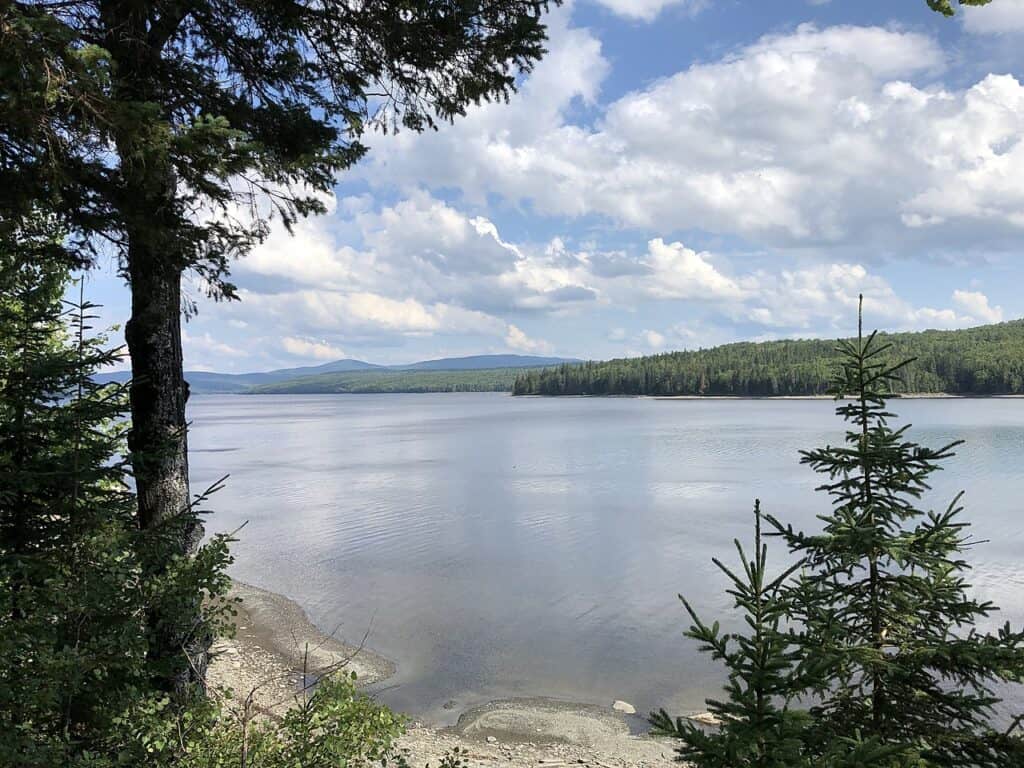
Nothing quite like the feeling of reeling in a big one from Bantam Lake.
©Dmoore5556 / Creative Commons – License
Connecticut River
The Connecticut River is a one-of-a-kind tidal fishing ground that spans the entire state. The upper river is dangerous to navigate and best tackled with a jet boat. But, the smallmouth bass here are massive, with six-pound catches being common.
Further downstream, the tides take over, and the lower sections of the river create a mixed bag of possible catches. The backwaters are a paradise for largemouth, perch, and crappie enthusiasts.
The fishing ground is also known for stripers, pike, carp, and channel catfish. During the yearly spring striper run, hordes of massive fish up to 50 pounds swim upstream to feast on shad and herring, creating a spectacle like no other.
Highland Lake
Highland Lake is a gem tucked away in the state’s northwest corner. It’s small but mighty, offering a top-notch bass fishery and plenty of other fishing opportunities to satisfy any enthusiast.
The sixty-foot-deep natural wonder is home to crappie and trout. Brown trout are regularly added to the lake; some survive and grow to impressive sizes. This helps the largemouth bass population, allowing them to grow to six or seven pounds by feasting on the trout.
What Are The Most Effective Baits And Lures To Catch Largemouth Bass?
Some of the most effective baits and lures for this type of fish include:
Spring: Spinnerbaits and Crankbaits
Early spring is a great time to target largemouth bass as they move shallow to spawn. Spinnerbaits and crankbaits are ideal for covering water and triggering reaction bites from pre-spawn and spawning bass.
Spinnerbaits have a metal blade that spins and flashes in the water, creating vibration and noise that attract bass. Crankbaits have a lip that makes them dive and wobble in the water, mimicking baitfish or crawfish. You can choose different sizes, hues, and depths for both lures to match the surroundings and the water quality.
Summer: Topwater and Plastic Worms
Largemouth bass tend to move deeper in summer to find cooler, more oxygenated water. However, they can still be caught on the surface during low-light periods or when there’s a lot of surface activity.
Topwater baits are designed to create noise and disturbance on the water surface, such as poppers, buzz baits, and frogs. These baits can trigger explosive strikes from bass-feeding insects, frogs, or baitfish.
Plastic worms are another practical option for summer bass fishing. They can be rigged in various ways, such as Texas rig, wacky rig, drop shot, or Carolina rig, and fished slowly along the bottom or around the cover. Plastic worms come in various shapes, colors, and sizes to imitate worms, leeches, or other creatures that bass eat.
Fall: Jigs and Swimbaits
Fall is when the largemouth bass fish feed heavily to prepare for winter. They often chase schools of baitfish in open water. Jigs and swimbaits are excellent choices for fall bass fishing. Jigs are weighted hooks with a skirt and a trailer that resemble crawfish or other bottom-dwelling prey.
Swimbaits are soft or hard baits with a realistic swimming action in the water. They come in various shapes and sizes to match the baitfish that bass are feeding on.
Winter: Jerkbaits and Spoons
Due to cold water temperatures, largemouth basses become less active and more selective in winter. They tend to suspend in deeper water or near cover and wait for an easy meal. Jerkbaits and spoons are two of the best baits to catch winter bass.
Jerkbaits are minnow-shaped baits with a suspending or slow-sinking action in the water. Spoons are metal baits with a curved shape that makes them flutter and flash in the water.
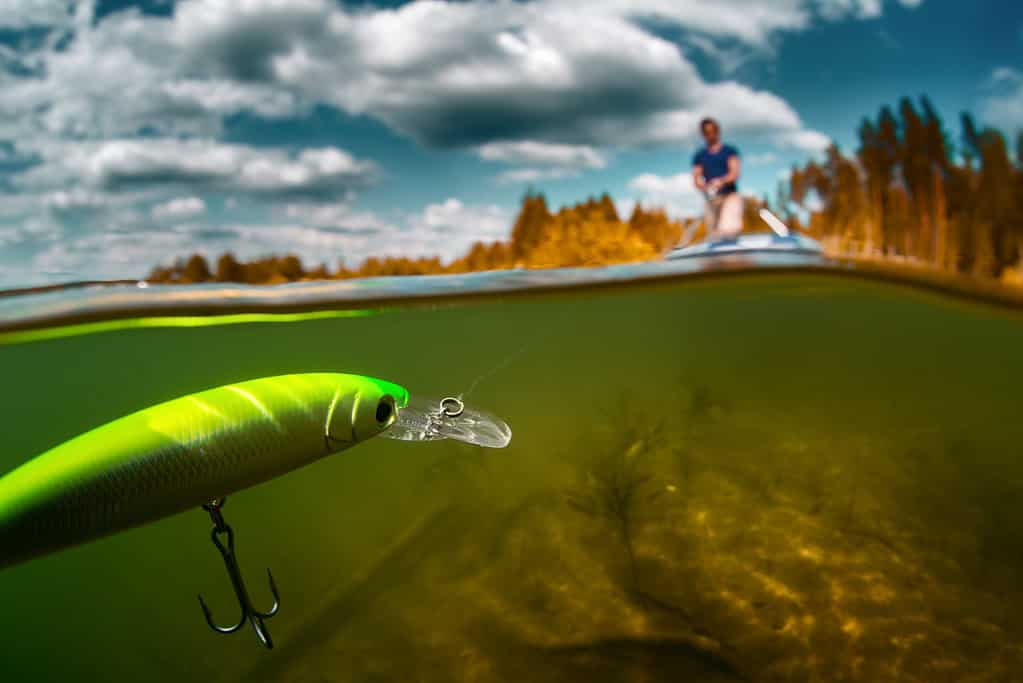
Classic pairing: Jerkbaits and spoons are a tried-and-true combination for targeting largemouth bass.
©Dudarev Mikhail/Shutterstock.com
Final thoughts on CT’s Biggest Largemouth Bass
The biggest largemouth bass ever hooked in Connecticut is a breathtaking phenomenon that has amazed fishermen and anglers alike. The size and weight of this amazing creature are awe-inspiring, and the seizing of it represents an extraordinary accomplishment that a fortunate angler can experience just once in their lifetime.
The photo featured at the top of this post is © iStock.com/Joe_Potato
Thank you for reading! Have some feedback for us? Contact the AZ Animals editorial team.



